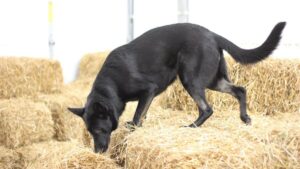
The Versatility of the German Shepherd Dog
Explore the versatility of the German Shepherd Dog, a breed celebrated for its loyalty, intelligence, and adaptability across diverse roles.
Home » Dog Breeds » German Shepherd Dog Breed


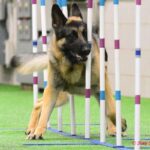


The German Shepherd Dog, often simply referred to as the German Shepherd or GSD, is one of the world’s most recognizable and popular breeds. Originating from Germany, this noble breed was originally developed for herding and guarding sheep, but its adaptability has since propelled it into a myriad of roles beyond its pastoral beginnings. Known for its versatility, intelligence, and loyalty, the GSD is lauded as an ideal working partner, serving many roles in police and military work as well as in search & rescue operations. The breed’s strong protective instincts, combined with its high trainability and eagerness to please, have also made the “Shepherd” a cherished family companion.
Herding
22 – 24 inches
50 – 90 pounds
7 – 10 years
| Country of Origin | Germany |
|---|---|
| Bred For | Herding, Guarding, Police Dog, Military Dog, Service Dog, Companionship |
| Known For | Intelligence, Movement, Trainability |
| Popularity | High |
| Temperament | Fearless, Loyal, Noble, Willing |
| Activities | Police Service, Military Service, Search & Rescue, Watchdog, Conformation Shows, Dog Sports |
The origins of the German Shepherd Dog trace back to late 19th-century Germany. The breed was developed primarily for the purpose of herding sheep and protecting them from predators. Given Germany’s vastness, there was a necessity for a hardworking, intelligent, and versatile dog capable of managing large flocks across varied terrain.
The man credited with the formal creation of the German Shepherd Dog as a distinct breed is Captain Max von Stephanitz. In the 1890s, he envisioned a German breed that would be unmatched in its capability as a herding dog. In 1899, after coming across a dog named Hektor Linksrhein, who possessed all the qualities he was looking for, von Stephanitz purchased the dog and changed his name to Horand von Grafrath. Horand would become the very first German Shepherd Dog registered and is considered the progenitor of the breed.
Von Stephanitz and his peers formed the Verein für Deutsche Schäferhunde (Society for the German Shepherd Dog) and worked diligently on refining the breed. They put a strong emphasis on traits such as intelligence, loyalty, and discipline. As industrialization spread across Germany and reduced the need for herding dogs, von Stephanitz advocated for the breed to be employed in other roles, such as police and military work, because of its adaptability and intelligence.
During World Wars I and II, the German Shepherd Dog’s valor and effectiveness as a Military, Rescue, and Messenger Dog became evident. The dogs’ exceptionalism brought them to the attention of the world, elevating their global popularity.
However, due to anti-German sentiment that followed the wars, the breed was renamed in many parts of the world. In England, the breed became known as the Alsatian, a name that persisted until 1977 when it reverted back to German Shepherd Dog.
The American Kennel Club recognized the German Shepherd Dog in 1908, and since then, the breed has been one of the most popular and recognized in the United States. Its roles have expanded from herding and protection to Search and Rescue, Police and Service Work, and of course, companionship.
The legacy of the German Shepherd Dog is not just its versatility but also its loyalty, bravery, and dedication to whatever task it undertakes. Whether it’s in the field herding sheep, in a war zone saving lives, or at home providing companionship, the German Shepherd has proved time and again why it remains one of the most revered dog breeds in the world.
Adult male German Shepherd Dogs typically stand between 24 and 26 inches tall at the shoulder, with mature females being slightly shorter, usually ranging from 22 to 24 inches.
In terms of weight, males usually fall within the 65 to 90 pounds range, while females tend to be lighter, weighing in between 50 and 70 pounds.
The German Shepherd Dog embodies a balance of strength and agility. When observed in profile, the breed is longer than tall by a ratio of 10 to 8.5 as measured from the prosternum to the rear edge of the pelvis. Length, however, is not achieved by a long back. Instead, the ribs are carried well back and the loin is relatively short. The result is a dog that is substantial, not spindly, with a well-muscled frame and an unmistakable nimbleness and nobility.
Texture: The double coat of the German Shepherd Dog can be described as dense and straight, with the presence of a harsh outer layer and a thick, insulating undercoat. The outer coat lies close to the body and is dense, harsh, and straight, although a slightly wavy topcoat is acceptable. The ideal coat is of medium length, but the head, foreface, ears, front of the legs, and feet are covered with short hair. The coat on the neck is generally thicker and longer, and the tail typically presents a rather bushy appearance. Soft, silky, woolly, curly, open, or long coats are unacceptable in the breed.
| Standard Color | |
|---|---|
| Black | ee |
| Black & Cream | ee |
| Black & Red/td> | ee |
| Black & Silver | ee |
| Black & Tan | ee |
| Gray | ee |
| Sable | ee |
| White | ee |
| Liver | ee |
| Blue | ee |
| Bi-Color | ee |
A Note About Color: Typically, the German Shepherd Dog appears in a variety of rich colors, including expressions of saddle, sable, bi-color, and solid black. Pale colors, and diluted blues and livers, are serious faults. A GSD must have a solid black nose, and a white dog is unacceptable in the breed.
The tail of the German Shepherd Dog is bushy and reaches at least to the hock, but not beyond the mid-point of the metatarsus. It hangs in a gentle curve when the dog is at rest. When in motion or excited, the curve may become more pronounced, but the tail is never raised beyond the level of the back. The tail offers a balanced continuation of the topline, adding elegance to the dog’s silhouette. A natural tail is a defining characteristic of the breed.
Owning a German Shepherd Dog is a commitment to a loyal, intelligent, and versatile canine companion. These dogs are known for their dedication to their families, and their alertness makes them outstanding guardians. However, the breed’s strong working lineage also means they require regular mental and physical stimulation. Training, socialization, and daily engagement are crucial to ensure they develop into well-rounded partners. Without proper training, their protective instincts can become misdirected, and without sufficient exercise, they can become restless or even destructive.
German Shepherds are generally robust and healthy dogs, but like all breeds and mixed breeds, they can be susceptible to certain health conditions. Regular veterinary check-ups, a balanced diet, and an active lifestyle can help to maintain a longer, healthier life for this breed.
Lifespan: The average lifespan for a German Shepherd Dog ranges from 7 to 10 years. However, with proper care and regular medical attention, many live longer, fulfilling lives.
German Shepherd Dogs, while robust and generally healthy, can be predisposed to certain health concerns. Some of the more common issues include:
Regular health screenings and early detection can help with managing or even preventing some of these conditions. Annual check-ups with a veterinarian, along with a watchful eye for any unusual signs or behaviors, are crucial for the well-being of a German Shepherd Dog.
German Shepherd Dogs have an innate desire to please their people, although their sheer intelligence and dynamic energy can prove challenging for novice dog owners. Their keen minds thrive on stimulation and purpose, and without proper engagement, they may resort to undesirable behaviors out of boredom or frustration. It’s essential, therefore, for potential GSD owners to understand the commitment to training and mental stimulation required to raise a well-adjusted dog.
German Shepherds are not just emotionally intelligent; they are deeply sensitive creatures. They form profound connections with their families, and this bond manifests in various ways. They can be keenly attuned to their owner’s emotions and moods, often providing comfort or company when it’s most needed. However, this sensitivity also means they might struggle with changes in their environment or routine, needing reassurance and consistency.
Separation anxiety is not uncommon in German Shepherds. Their loyalty to their families means they thrive on companionship and may exhibit distress when left alone for extended periods. Owners need to be aware of this potential challenge and find ways to gradually acclimatize their dogs to short periods of solitude.
Socializing this breed from a young age is pivotal. Positive interactions with various people, animals, and environments can help to mold a well-rounded and confident adult dog. Given their protective instincts, German Shepherd Dogs naturally exhibit caution around strangers, making early socialization essential to prevent undue wariness or aggression.
German Shepherds typically coexist harmoniously with children, especially when raised with them. Their protective nature often extends to younger family members, making the breed an excellent family guardian. However, interactions with very young children should always be supervised, given the breed’s size and energy levels.
With other animals, especially other dogs, the behavior of the breed can vary. Some German Shepherd Dogs are sociable and play well with others, although it’s not uncommon for many to exhibit more dominant tendencies. Early and positive introductions to other animals can promote harmonious (but always supervised) interactions.
The German Shepherd Dog, being a large and active breed, has specific nutritional requirements that are crucial to its overall health, vitality, and longevity. A balanced and tailored diet not only fuels the dog’s daily activities, it also supports a muscular physique and caters to the breed’s metabolic rate.
Puppyhood is a critical phase in the life of a GSD, marked by rapid growth and development. During this period, a diet rich in proteins, fats, and essential nutrients is paramount. High-quality puppy food designed for large breeds ensures each puppy receives the calcium and phosphorus needed to support growing bones and joints. Given the breed’s rapid growth, portion control and multiple meals—usually three to four times a day—can aid in steady and healthy weight gain.
As German Shepherds transition into adulthood, their dietary needs evolve. While protein remains essential for muscle maintenance, the focus shifts towards maintaining an ideal weight and supporting their active lifestyle. Premium adult dog food, rich in meat-based proteins, wholesome grains, and essential fatty acids, is ideal. The inclusion of Omega-3 and Omega-6 fatty acids can benefit skin and coat health, while glucosamine and chondroitin can support joint health, particularly crucial for a breed prone to hip dysplasia.
The amount of food that a German Shepherd requires can vary based on several factors. Age, metabolism, activity level, and overall health play pivotal roles in determining a dog’s daily caloric intake. On average, an adult GSD may consume 2 to 4 cups of high-quality dog food daily, split into two meals. However, active or working dogs might require more food to meet their energy demands, while more sedentary or senior dogs will likely need less.
It’s crucial for owners to monitor their German Shepherd’s weight and body condition. Regularly feeling the dog’s ribs, observing the waistline, and watching for signs of excess weight can guide adjustments at mealtime. Obesity can lead to numerous health problems, so maintaining an ideal weight is vital.
Lastly, hydration plays an equally important role in a German Shepherd Dog’s diet. Providing constant access to fresh and clean water is essential, especially after exercise or during warmer summer months.
Training is a cornerstone of the German Shepherd Dog’s life. The breed’s intelligence, drive, and willingness to work makes it exceptionally trainable, but it also means it requires consistent and structured guidance. These characteristics, combined with the breed’s size and energy, underscore the importance of early and ongoing training.
Training during puppyhood lays the foundation for a well-behaved adult dog. Basic commands such as “sit,” “stay,” and “come” are essential. Equally crucial is early socialization, where the puppy is exposed to various people, environments, sounds, and other animals. This broad exposure helps to develop a confident and well-adjusted adult German Shepherd.
Given the breed’s size and strength, obedience training is a must. German Shepherds thrive in structured environments where they understand what is expected of them. Reinforcing positive behaviors with rewards, and consistent redirection of undesired behaviors, helps with building a bond of trust and respect between the dog and the owner.
Beyond learning basic commands, the GSD benefits immensely from tasks that challenge the breed’s intelligence. Puzzle toys, advanced Obedience, Tracking exercises, and Agility training can keep the dog’s mind sharp. Given its heritage as a working dog, the breed typically enjoys activities that mimic tasks, such as Herding Trials or Search and Rescue exercises.
While German Shepherds are known for their loyalty and protective nature, these traits can manifest as overprotectiveness or even aggression without proper training. It’s essential to teach these dogs from a young age when to be alert and when to be at ease. Addressing unnecessary barking, digging, or chewing early on prevents these behaviors from becoming problematic habits.
Positive reinforcement, where good behavior is rewarded with treats, praise, or play, is highly effective with German Shepherds. These dogs are eager to please, so acknowledging their good behavior strengthens the bond with their handler. Conversely, harsh or punitive methods can be counterproductive, leading to distrust, fear or aggression.
Perhaps the most critical aspect of training a German Shepherd Dog is consistency. Mixed signals or sporadic training can confuse the dog and lead to undesirable behaviors. Whether it’s house training, command training, or behavioral modification, consistent messaging and routine are paramount.
Originating as a working dog bred primarily for herding and guarding sheep, the German Shepherd Dog possesses a high drive and notable stamina. These attributes, combined with the breed’s intelligence and eagerness, necessitate an exercise regimen that caters to both its body and mind.
| Energy Level | High |
|---|---|
| Exercise Requirements | 2 Hours/Day (Minimum), Daily Walks, Regular Exercise, Playing with Another Dog, Mental Stimulation |
A young German Shepherd is a bundle of energy, often exhibiting its playful side through games and exploration. Regular play sessions, whether a spirited game of fetch or a romp in a secured yard, meet its need for physical activity and also foster deeper bonds between the dog and its owner. Such play sessions also serve as a controlled environment where the GSD can be taught boundaries and appropriate play behavior.
Daily walks are fundamental to the exercise routine of a German Shepherd Dog. Ranging from 45 minutes to over an hour, these walks provide the dog with mental stimulation through the myriad of scents, sights, and sounds it encounters. This sensory enrichment is invaluable for keeping the dog engaged and content.
As the German Shepherd matures, its inherent drive and capabilities can be channeled into specific activities. Given its roots in herding, Herding Trials, or even simulated herding games, can be immensely satisfying for the dog. Similarly, due to its keen sense of smell and alertness, Scent Work or Tracking exercises can be both stimulating and rewarding.
Structured training beyond basic commands also doubles as exercise. Whether it’s Agility training, advanced Obedience, or even Protection work, the German Shepherd is equipped to excel. These activities not only challenge the dog’s physical capabilities, it also engages its sharp intellect, making training both fun and productive.
While it’s essential to ensure the German Shepherd Dog receives adequate exercise, overexertion, especially in puppies, can be detrimental. Their developing bones and joints can be susceptible to injuries if overworked. Hence, it’s crucial to strike a balance, taking cues from the dog’s behavior and energy levels. Having access to fresh water and providing regular breaks during exercise sessions can prevent dehydration and fatigue.
The German Shepherd Dog’s iconic coat, with its dense undercoat and straight or slightly wavy outer coat, serves practical functions—from protection against inclement weather to providing a bit of cushion during workouts. However, this also means the breed has specific grooming requirements that will ensure its coat remains in top condition and any health concerns are kept at bay.
| Coat Type | Double, Harsh, Dense, Medium Length, Shedding |
|---|---|
| Grooming Requirements | Weekly Brushing, Occasional Bathing, Routine Ear Cleaning, Periodic Nail Trimming, Regular Tooth Brushing |
Brushing is a crucial aspect of grooming for the German Shepherd. Given its double coat, the breed sheds year-round, with a notable “blow out” during the shedding seasons of spring and fall. Regular brushing, preferably multiple times a week, helps to remove the loose hairs, reduces matting, and distributes the natural oils across the coat. During periods of profuse shedding, daily brushing can help with managing the increased volume of loose hair.
Bathing a GSD is essential but should not be needed frequently. Overbathing can strip the coat of its natural oils, leading to dry skin and potential irritation. Instead, bathing once every month, or when the dog is notably dirty, is typically sufficient. Always use a dog-specific shampoo that caters to the needs of the dog’s skin and coat.
The German Shepherd’s ears stand erect, making them prone to accumulating dirt and debris. Weekly ear cleaning with a veterinarian-recommended cleanser can prevent infections. Additionally, while the breed is not prone to excessive wax build-up, periodic checks will ensure early detection of potential issues.
Dental hygiene plays a pivotal role in the overall health of a German Shepherd. Daily brushing with a canine toothpaste can prevent tartar build-up and gum diseases. Dental chews or toys can serve as supplementary tools to promote dental health, but they don’t replace the efficacy of regular brushing.
Nail trimming is another essential grooming aspect. If a GSD doesn’t naturally wear down its nails through activity, regular trimming, usually every 3-4 weeks, will keep the nails at an appropriate length. Overgrown nails can affect the dog’s movement and lead to general discomfort and pain.
Finally, a routine check of the German Shepherd Dog’s eyes, nose, feet, and underbelly can alert the owner to any anomalies such as rashes, sores, injuries, and signs of infection. These health checks, combined with regular vet visits, can identify potential health issues before they become serious.
Living with a German Shepherd Dog is a rewarding experience, enriched through unwavering loyalty and companionship. However, given the breed’s size, energy, and working history, there are several considerations that will ensure its well-being and contentment in almost any living environment.
German Shepherds are large, active dogs that benefit from having ample space to move, play, and explore. While they can adapt to apartment living, it’s essential that they receive adequate outdoor exercise daily. Homes with fenced yards offer a safe space for the dog to play and run, but given the breed’s intelligence and penchant for escape, it’s essential to be sure the fence is always secure.
The double coat of the GSD offers protection against both cold and moderate heat. These dogs can handle colder climates relatively well, but during hot weather, it’s crucial to provide shade and water, and to limit excessive activity during peak hours of excessive heat.
German Shepherds, with their keen senses and natural protective instinct, are often alert to their surroundings. Inside the home, they prefer to be involved in family activities and will stay close to their human companions. Providing them with a dedicated space or bed can give them a sense of security.
The breed is inherently social and bonds deeply with its family. These dogs thrive on interaction and can become distressed or develop behavioral issues if left alone for extended periods. It’s beneficial to integrate them into daily routines, be it a walk, playtime, or even simple companionship while working.
German Shepherds, when introduced appropriately, generally coexist peacefully with other household pets. However, early socialization, supervised introductions, and understanding the individual dog’s temperament are crucial. Their herding instincts might occasionally come to the forefront, especially with smaller animals.
Due to the breed’s sometimes intimidating appearance and strong protective instinct, it’s essential to be sure interactions between a German Shepherd Dog and human strangers, houseguests, and unfamiliar animals are carefully managed. Training and early socialization can aid in making these encounters more predictable and positive.
The sight of a litter of German Shepherd Dog puppies, with their floppy ears and curious eyes, can melt any heart. However, raising one of these beauties comes with its own set of challenges and rewards. The goal is to utilize the puppy phase as the foundation upon which a strong, well-adjusted adult GSD is built.
Welcoming a puppy into one’s life is an engaging journey that requires commitment and understanding. However, the German Shepherd puppy’s dynamic nature, combined with its intrinsic drive, makes this a breed apart from all the rest.
As GSD puppies are both curious and active, ensuring a safe environment is essential. It’s always necessary to puppy-proof the home, keeping a vigilant eye to deter the little one from potential hazards like chewing on wires or accessing unsafe areas.
The German Shepherd puppy has a robust growth trajectory. Feeding a balanced, high-quality puppy food is vital to support the youngster’s skeletal and muscular development. Consistency in feeding times also helps to instill discipline early on.
Given the breed’s susceptibility to specific conditions like hip dysplasia, regular veterinary check-ups, particularly in the first year, are essential. These visits will encompass necessary vaccinations, preventive care, and growth monitoring.
The intelligence of the German Shepherd Dog is widely acknowledged, even among the puppies. This makes the GSD pup highly trainable, but it also underscores the importance of starting obedience training at a young age. Structured, positive reinforcement-based training methods are most effective, setting the stage for a disciplined adult dog.
Early socialization is crucial for the German Shepherd Dog. Exposing a puppy to a variety of environments, sounds, people, and other animals instills confidence and makes this breed a pleasure to be around. It’s a proactive way to make sure the GSD puppy grows up to become a secure and sociable adult without any unwarranted aggression or fear.
The German Shepherd Dog is a breed known for its versatile capabilities, tireless work ethic, and keen intelligence. This combination of traits makes the breed a prime candidate for a range of activities and dog sports that cater to its physical and mental needs.
The German Shepherd Dog is recognized by the world’s leading registries and kennel organizations, which categorize the breed into a specific Group based on its unique characteristics. This breed is recognized worldwide under the following Group designations:
| Organization | Group Designation |
|---|---|
| AKC (American Kennel Club) | Herding |
| UKC (United Kennel Club) | Herding Dog |
| CKC (Canadian Kennel Club) | Herding |
| ANKC (Australian National Kennel Council) | Working Dogs |
| RKC (The Royal Kennel Club) | Pastoral |
| FCI (Fédération Cynologique Internationale) | Group 1 – Sheepdogs and Cattle Dogs; Section 1 – Sheepdogs |
The ideal German Shepherd Dog is described by a Breed Standard that is approved by each of the world’s leading registries and kennel organizations. The Breed Standards for this breed may be found in the following links:
| Organization | Breed Standard |
|---|---|
| American Kennel Club | AKC German Shepherd Dog Breed Standard |
| United Kennel Club | UKC German Shepherd Dog Breed Standard |
| Canadian Kennel Club | CKC German Shepherd Dog Breed Standard |
| Australian National Kennel Council | ANKC German Shepherd Dog Breed Standard |
| The Royal Kennel Club | RKC German Shepherd Dog Breed Standard |
| Fédération Cynologique Internationale | FCI German Shepherd Dog Breed Standard |
The German Shepherd Dog, with its worldwide popularity and significant contributions in a variety of roles, has been championed and supported by numerous breed-specific clubs. These organizations are dedicated to preserving the breed’s integrity, promoting its health, and fostering its versatility across multiple disciplines.
The German Shepherd Dog Club of America (GSDCA) is the primary and oldest organization dedicated to the breed in the United States. Founded in 1913, GSDCA has been instrumental in promoting the breed’s usefulness, safeguarding responsible breeding practices, and educating enthusiasts about the nuances and needs of the GSD.
In Canada, the German Shepherd Dog Club of Canada (GSDCC) takes the lead in representing the breed. GSDCC is dedicated to the betterment of the GSD through educational initiatives, promoting responsible ownership, and encouraging participation in a variety of canine activities suitable for the breed.
In the United Kingdom, the German Shepherd Dog League of Great Britain is a major advocate for the breed. Established in the early 20th century, this club has a long-standing history of promoting the health and welfare of the GSD wherever it is found.
Membership in these clubs offers German Shepherd Dog enthusiasts a wealth of resources, from training and health advice to participation in specialty shows and working trials. Engaging with such organizations provides participants with the best standards and practices for the care, training, and breeding of this iconic purebred.
German Shepherd Dogs, despite their popularity, occasionally find themselves in need of rescue due to various circumstances. The breed’s high energy, intelligence, and training needs can sometimes be overwhelming for unprepared or ill-informed owners. As a result, there are dedicated rescue organizations that specifically cater to GSDs, ensuring they receive proper care, rehabilitation, and, ultimately, placement in a loving, forever home.
Nationally recognized groups in the United States include the German Shepherd Rescue and Adoptions and the Shepherd’s Hope Rescue. These organizations, along with local rescues, tirelessly work to provide GSDs with a second chance at a loving home.
In Canada, organizations such as the German Shepherd Rescue of BC have played a pivotal role in the well-being of the breed, focusing on both rescuing dogs and raising awareness about responsible pet ownership.
In the United Kingdom, groups like the German Shepherd Rescue Elite are at the forefront of providing every GSD with the love, care, and training it needs to thrive in a new home.
For those considering adding a German Shepherd Dog to their family, reaching out to a rescue group can be a rewarding way to provide a loving home to a dog in need. It’s also a great way to gain a loyal companion in the process.
Yes, the German Shepherd Dog can be a good family dog, but there are some important considerations. Although these are loyal and intelligent dogs, their size, energy levels, and protective instincts mean they may not be the best choice for every situation. Proper training, early socialization, and regular exercise are essential to ensure a puppy grows up to become a well-adjusted adult.
German Shepherds are social animals and generally do not do well when left alone for long periods of time. They thrive on companionship and interaction, so leaving them alone for extended lengths could lead to separation anxiety and behavioral issues. If a dog needs to be left alone, it’s important to do so gradually and provide plenty of mental and physical stimulation when no one is present.
German Shepherd Dogs are known for their vocal nature, and they can indeed bark a lot if not properly trained and socialized. Barking is their way of communicating and can be triggered by various stimuli, including strangers, other animals, and changes in their environment. Early training and socialization can help to manage a dog’s barking tendencies and teach it when it’s appropriate to bark.
German Shepherds are known for their loyalty and can form strong bonds with multiple family members. While they might show a deeper connection to one person, they can still be affectionate and loyal to others in the household. Their loyalty often extends to their role as protectors, making them committed to the well-being of their entire family.
The German Shepherd Dog falls somewhere between moderate and high maintenance. The breed’s high intelligence and energy levels mean these dogs need mental stimulation and physical exercise to stay in good condition. Their health and behavior benefit greatly from consistent socialization and mindful training. It’s also important to remember the breed’s thick double coat requires regular brushing, especially during shedding seasons.

Explore the versatility of the German Shepherd Dog, a breed celebrated for its loyalty, intelligence, and adaptability across diverse roles.
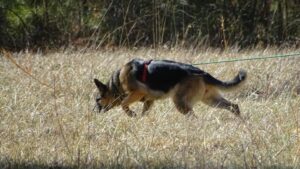
Explore form and function of the German Shepherd, from its origins as a sheep-tending breed in Germany to its roles in modern society.

Interview with Laurie King Telfair, the breeder of Tesla German Shepherd Dogs. Read about the kennel’s beginnings, the puppies, and more.

Discover a mother-daughter duo’s journey from dog enthusiasts to national recognition in Windmill German Shepherds and Cardigan Welsh Corgis.
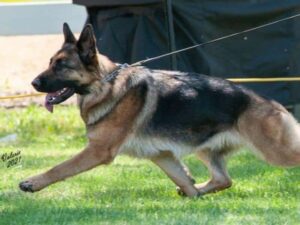
Learn how to expertly assess German Shepherd dogs with the loose leash temperament evaluation pocedure and ensure top-notch judging!

Interview with 2022 AKC Breeder of the Year Herding Group Honoree, Gloria Birch of Covy-Tucker Hill German Shepherd Dogs.
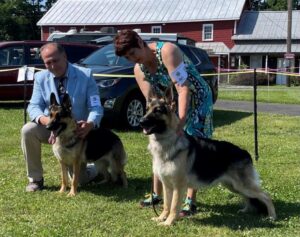
Insights from an Owner Handler, Dara Conklin. Read about her opinions on various topics about dog handling in the modern show ring.

Life with dogs. It’s really about the dogs—a personal history accented by the dogs who’ve made me a better person.

Explore the versatility of the German Shepherd Dog, a breed celebrated for its loyalty, intelligence, and adaptability across diverse roles.

Explore form and function of the German Shepherd, from its origins as a sheep-tending breed in Germany to its roles in modern society.

Interview with Laurie King Telfair, the breeder of Tesla German Shepherd Dogs. Read about the kennel’s beginnings, the puppies, and more.

Discover a mother-daughter duo’s journey from dog enthusiasts to national recognition in Windmill German Shepherds and Cardigan Welsh Corgis.

Learn how to expertly assess German Shepherd dogs with the loose leash temperament evaluation pocedure and ensure top-notch judging!

Interview with 2022 AKC Breeder of the Year Herding Group Honoree, Gloria Birch of Covy-Tucker Hill German Shepherd Dogs.

Insights from an Owner Handler, Dara Conklin. Read about her opinions on various topics about dog handling in the modern show ring.

Life with dogs. It’s really about the dogs—a personal history accented by the dogs who’ve made me a better person.
The best way to ensure a long and happy relationship with a purebred dog is to purchase one from a responsible breeder. Not sure where to begin?
Contact the National Parent Club’s Breeder Referral Program, which is listed on the AKC Breeder Referral Contacts page.
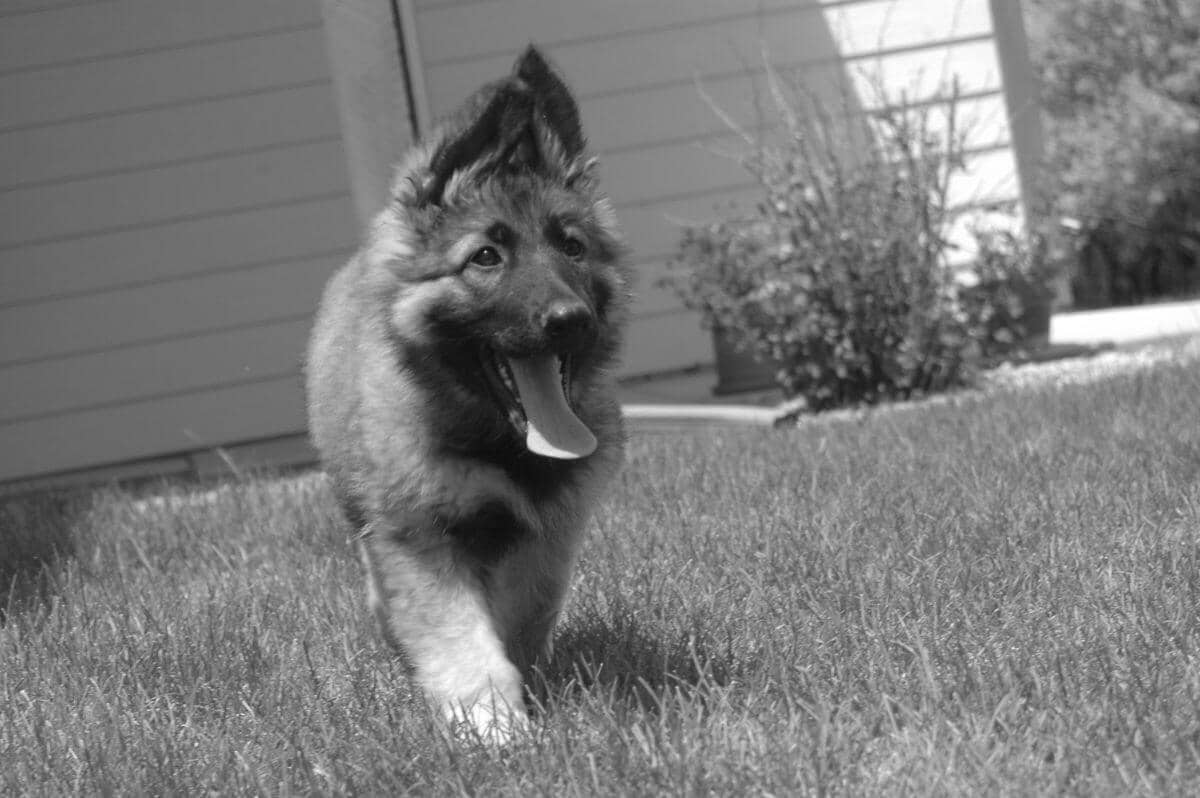

"*" indicates required fields
Showsight Magazine–the world’s most influential purebred dog publication since 1992. Each issue reaches a global audience dedicated to preserving the history and health of purpose bred dogs. Filled with award-winning editorial focused on news and insights from the dog show community, top breeders, handlers, AKC Judges, and more!